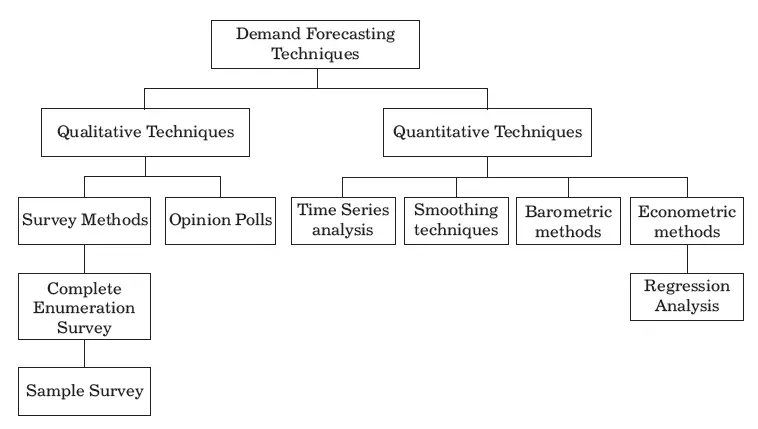What is Demand forecasting?
Demand forecasting is a process of predicting the demand for an organisation’s products or services in a specified time period in the future.

Table of Content [Show]
Techniques & Methods of Demand Forecasting
Different organisations rely on different techniques to forecast demand for their products or services for a future time period depending on their requirements and budget.
Methods of demand forecasting are broadly categorised into two types. Let us discuss these techniques & methods of demand forecasting in detail:

Qualitative Techniques
Qualitative techniques rely on collecting data on the buying behaviour of consumers from experts or through conducting surveys in order to forecast demand.These techniques are generally used to make shortterm forecasts of demand.
Qualitative techniques are especially useful in situations when historical data is not available; for example, introduction of a new product or service. These techniques are based on experience, judgment, intuition, conjecture, etc.
Survey Methods
Survey methods are the most commonly used methods of forecasting demand in the short run. This method relies on the future purchase plans of consumers and their intentions to anticipate demand.
Thus, in this method, an organization conducts surveys with consumers to determine the demand for their existing products and services and anticipate the future demand accordingly. The two types of survey methods are explained as follows:
- Complete enumeration survey: This method is also referred to as the census method of demand forecasting. In this method, almost all potential users of the product are contacted and surveyed about their purchasing plans.
Based on these surveys, demand forecasts are made. The aggregate demand forecasts are attained by totalling the probable demands of all individual consumers in the market. - Sample survey: In this method, only a few potential consumers (called sample) are selected from the market and surveyed. In this method, the average demand is calculated based on the information gathered from the sample.
Opinion poll
Opinion poll methods involve taking the opinion of those who possess knowledge of market trends, such as sales representatives, marketing experts, and consultants.
The most commonly used opinion polls methods are explained as follows:
- Expert opinion method: In this method, sales representatives of different organisations get in touch with consumers in specific areas. They gather information related to consumers’ buying behaviour, their reactions and responses to market changes, their opinion about new products, etc.
- Delphi method: In this method, market experts are provided with the estimates and assumptions of forecasts made by other experts in the industry. Experts may reconsider and revise their own estimates and assumptions based on the information provided by other experts.
- Market studies and experiments: This method is also referred to as market experiment method. In this method, organisations initially select certain aspects of a market such as population, income levels, cultural and social background, occupational distribution, and consumers’ tastes and preferences.
Among all these aspects, one aspect is selected and its effect on demand is determined while keeping all other aspects constant.
Quantitative Techniques
Quantitative techniques for demand forecasting usually make use of statistical tools. In these techniques, demand is forecasted based on historical data.
These methods are generally used to make long-term forecasts of demand. Unlike survey methods, statistical methods are cost effective and reliable as the element of subjectivity is minimum in these methods. Let us discuss different types of quantitative methods:
Time Series Analysis
Time series analysis or trend projection method is one of the most popular methods used by organisations for the prediction of demand in the long run. The term time series refers to a sequential order of values of a variable (called trend) at equal time intervals.
Using trends, an organisation can predict the demand for its products and services for the projected time. There are four main components of time series analysis that an organisation must take into consideration while forecasting the demand for its products and services. These components are:
- Trend component: The trend component in time series analysis accounts for the gradual shift in the time series to a relatively higher or lower value over a long period of time.
- Cyclical component: The cyclical component in time series analysis accounts for the regular pattern of sequences of values above and below the trend line lasting more than one year.
- Seasonal component: The seasonal component in time series analysis accounts for regular patterns of variability within certain time periods, such as a year.
- Irregular component: The irregular component in time series analysis accounts for a short term, unanticipated and non-recurring factors that affect the values of the time series.
Smoothing Techniques
In cases where the time series lacks significant trends, smoothing techniques can be used for demand forecasting. Smoothing techniques are used to eliminate a random variation from the historical demand.
This helps in identifying demand patterns and demand levels that can be used to estimate future demand. The most common methods used in smoothing techniques of demand forecasting are simple moving average method and weighted moving average method.
The simple moving average method is used to calculate the mean of average prices over a period of time and plot these mean prices on a graph which acts as a scale.
For example, a five-day simple moving average is the sum of values of all five days divided by five.
The weighted moving average method uses a predefined number of time periods to calculate the average, all of which have the same importance.
For example, in a four-month moving average, each month represents 25% of the moving average.
Barometric Methods
Barometric methods are used to speculate the future trends based on current developments. This methods are also referred to as the leading indicators approach to demand forecasting.
Many economists use barometric methods to forecast trends in business activities. The basic approach followed in barometric methods of demand analysis is to prepare an index of relevant economic indicators and forecast future trends based on the movements shown in the index.
The barometric methods make use of the following indicators:
- Leading indicators: When an event that has already occurred is considered to predict the future event, the past event would act as a leading indicator.
For example, the data relating to working women would act as a leading indicator for the demand of working women hostels. - Coincident indicators: These indicators move simultaneously with the current event.
For example, a number of employees in the non-agricultural sector, rate of unemployment, per capita income, etc., act as indicators for the current state of a nation’s economy. - Lagging indicators: These indicators include events that follow a change. Lagging indicators are critical to interpret how the economy would shape up in the future. These indicators are useful in predicting the future economic events.
For example, inflation, unemployment levels, etc. are the indicators of the performance of a country’s economy.
Econometric Methods
Econometric methods make use of statistical tools combined with economic theories to assess various economic variables (for example, price change, income level of consumers, changes in economic policies, and so on) for forecasting demand.
The forecasts made using econometric methods are much more reliable than any other demand forecasting method. An econometric model for demand forecasting could be single equation regression analysis or a system of simultaneous equations. A detailed explanation of regression analysis is given in the next section.
- Regression Analysis: The regression analysis method for demand forecasting measures the relationship between two variables. Using regression analysis a relationship is established between the dependent (quantity demanded) and independent variable (income of the consumer, price of related goods, advertisements, etc.).
For example, regression analysis may be used to establish a relationship between the income of consumers and their demand for a luxury product. In other words, regression analysis is a statistical tool to estimate the unknown value of a variable when the value of the other variable is known.
After establishing the relationship, the regression equation is derived assuming the relationship between variables is linear.
The formula for a simple linear regression is as follows:
Y =a + bX
Where Y is the dependent variable for which the demand needs to be forecasted; b is the slope of the regression curve; X is the independent variable; and a is the Y-intercept. The intercept a will be equal to Y if the value of X is zero.
Leave a Reply